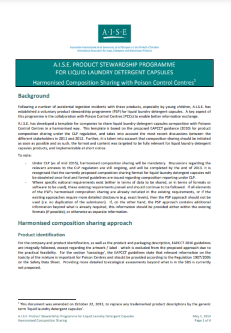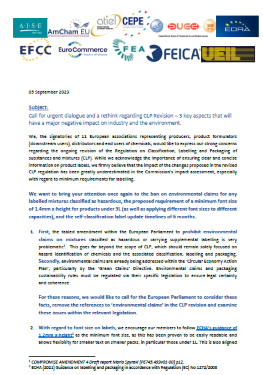The EU Regulation on CLP (Classification, Labelling, and Packaging) is a European Union regulation that governs the classification and labelling of chemical substances and mixtures. It is Regulation (EC) No 1272/2008 of the European Parliament and of the Council, and it has been in effect since January 20, 2009. The CLP Regulation replaced the previous system known as the Dangerous Substances Directive (DSD) and the Dangerous Preparations Directive (DPD).
The primary objectives of the EU CLP Regulation are as follows:
- Classification: The CLP Regulation establishes a standardized system for classifying chemicals based on their intrinsic hazardous properties. This classification is essential for identifying and communicating the potential risks associated with chemicals.
- Labelling: It sets rules for labelling chemicals and mixtures consistently across the European Union. Labels must include hazard pictograms, signal words, hazard statements, and precautionary statements to convey information about the dangers posed by the product.
- Packaging: The regulation also includes requirements for the packaging of hazardous chemicals to minimize risks during storage, transportation, and use.
- Communication: CLP ensures that information on the classification and labelling of chemicals is communicated effectively throughout the supply chain, from manufacturers to end-users. This helps in protecting human health and the environment.
- Harmonisation: CLP aligns the EU system with the Globally Harmonized System of Classification and Labelling of Chemicals (GHS), which is a globally recognised system for classifying and labelling hazardous substances and mixtures. This alignment facilitates international trade and the exchange of information on chemical hazards.
Ensuring correct implementation of CLP
The CLP Regulation applies to all chemicals, including substances and mixtures, and it has a significant impact on various industries, such as chemical manufacturing, chemical distribution, and downstream users of chemicals. It is designed to improve the safety and protection of human health and the environment by providing clear and standardized information about the hazards associated with chemicals. Companies that produce, import, or use chemicals in the EU must comply with the requirements of the CLP Regulation, ensuring proper classification, labelling, and packaging of their products.
For A.I.S.E. the correct understanding and thus implementation of CLP is essential to ensure the safety and safe use of its products by end users.
Harmonised information for emergency response
Annex VIII of CLP relates to the harmonised information on emergency health response. It provides specific requirements for the submission of information about hazardous chemical mixtures to appointed bodies within the EU such as the European Poison Centres. The purpose of Annex VIII is to ensure that emergency responders have access to critical information to handle chemical incidents safely and effectively.
A Unique Formula Identifier for each product
One of the components of the EU’s CLP Regulation is the recently introduced Unique Formula Identifier or UFI code. The UFI code is a unique alphanumeric code assigned to hazardous mixtures within the European Union (EU); including detergents. The UFI code serves as a tool for Poison Centres to quickly and accurately identify the specific formulation of a hazardous mixture, helping them provide the appropriate advice and medical treatment in the event of exposure or an emergency.
A.I.S.E. has supported ECHA in an EU wide communications campaign to raise awareness of the UFI code on products containing chemicals, particularly amongst parents with young children.
Enhanced user protection
Depending on the hazard of a chemical and where it is used, special requirements may be required to enhance protection for the user and vulnerable members of society. These include:

Child Resistant Fastenings (CRF) are an example of a special packaging requirement that help to protect vulnerable people (i.e. young children) when particularly hazardous chemicals are made available to the general public.

Tactile Warning of Danger (TWD) are an example of a special packaging requirement that help to protect vulnerable people (i.e. the blind or partially sighted) when particularly hazardous chemicals are made available to the general public.

Online sale of chemicals: When a hazardous mixture is made available for sale to the general public and they cannot see the on-pack label in advance of purchase (e.g. internet sale), the CLP Regulation requires that the purchaser receives hazard information via the advertisement of sale. Consequently, CLP online sales obligations may apply to a broad range of advertisers such as importers, formulators, re-fillers/re-packagers/re-labellers, retailers, wholesalers or distributors who sell hazardous mixtures to the general public.
Specific provisions for liquid detergent capsules
In 2014, CLP was amended and the Soluble Packaging Regulation introduced (EU) 1297/2014. This introduced specific provisions into CLP for LLDCs classified as hazardous according to the Regulation. In doing so, this made many aspects of the industry’s product stewardship programme mandatory in EU legislation, while also introducing additional requirements for the capsules.
The Soluble Packaging Regulation requires that liquid laundry detergent capsules are delivered in opaque or obscure outer packaging that always bears the precautionary statement “Keep out of reach of children”, and that has closures that are difficult for small children to open. The soluble film of the capsules has to resist compression up to a pressure of 300 Newton, it has to retain the liquid content for at least 30 seconds when immersed in water, and it has to contain a safe aversive agent that causes a fast repulsive reaction in case of accidental contact with the mouth.
In absence of formal guidance on the implementation of the CLP requirements, A.I.S.E. has developed practical tools and guidance for the industry on:
- The reduced visibility of the capsules through the outer packaging
- The P102 CLP precautionary sentence on-pack labelling (safe use instructions)
- Child-impeding closures
- Measuring oral rejection time and thereby determining effective levels of aversive agent in the soluble film
- Measuring the liquid containment function of soluble packaging through a dynamometric test protocol and a film dissolution test protocol.
A.I.S.E.’s Product Stewardship Programme for Liquid Detergent Capsules
A.I.S.E.’s joint reporting with Poison Centres
A collective industry approach for CLP compliance
The Detergent Industry Network for CLP Classification (DetNet) is a platform that helps detergents manufacturers to classify and label their products in accordance with the EU Classification, Labelling and Packaging Regulation (CLP) in order to comply with the requirements.
Current revision of the CLP Regulation
A.I.S.E. is actively engaged in the current revision of CLP and supports the objectives of the revision, to ensure a high level of protection of human health and the environment as well as the free movement of chemicals, while enhancing competitiveness and innovation. While some of the proposed amendments are in keeping with the objectives of CLP, A.I.S.E has raised concern with certain provisions in the revision.
These concern label formatting rules and label design; the use of fold out labels; transition periods for the updates of labels; advertisements requirements; refill sales; digital label elements; grouping of substances and non-animal approaches.
Read more:







